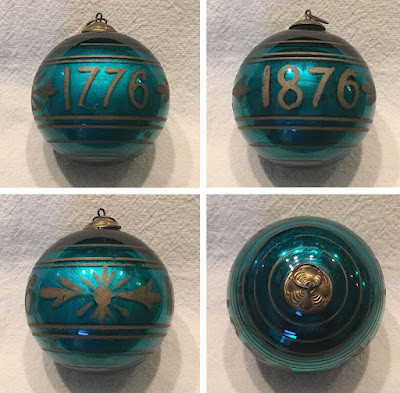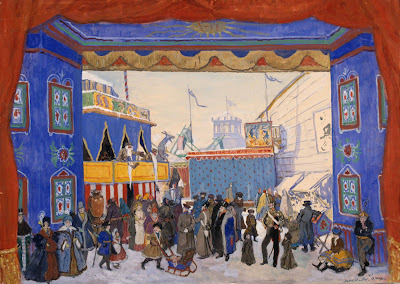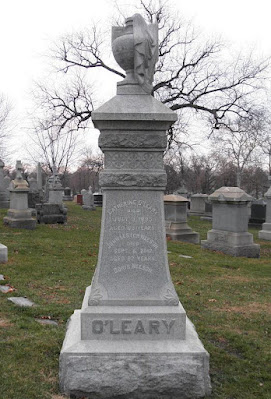The idea for this
month’s article began with a postcard. Among recently acquired Glessner family
items was a framed real photo postcard from 1916 featuring a portrait of the
Swiss conductor Ernest Ansermet, with a short message in French on the reverse
addressed to Frances Glessner Lee. A quick review of Frances Glessner’s journal
confirmed how Frances Glessner Lee and Ansermet met. A deeper dive into
Ansermet’s reason for coming to Chicago that year uncovered a long-forgotten
story of one of the most controversial performances to ever take place upon the
Chicago stage.
The Ballet Russes
 Sergei Diaghilev
Sergei Diaghilev (Leon Bakst, 1906)
The Ballet Russes was
the brainchild of the great Russian impresario Sergei Diaghilev. Formed in
Paris in 1909, the ballet company created a huge sensation with its boundary-pushing
performances that combined modern music, innovative choreography, and stunning
visual arts. Among those engaged by Diaghilev were Igor Stravinsky, Claude
Debussy, Sergei Prokofiev, Maurice Ravel, Vasily Kandinsky, Pablo Picasso,
Henri Matisse, Leon Bakst, and Coco Chanel. The company, which gained broad
exposure during tours through Europe and North and South America from 1909
through 1929, has long been regarded as the most influential ballet company of
the 20th century.

In 1916, New York’s
Metropolitan Opera Company arranged for the Ballet Russes to undertake a
multi-city U.S. tour. That tour included a two-week residency at the Auditorium
Theater in Chicago, to be managed by Frederick J. Wessels and Henry E. Voegeli,
the business manager and assistant manager, respectively, of the Chicago
Symphony Orchestra. The company, which comprised about 200 “artistes direct
from Russia” arrived in Chicago on February 13 aboard a special train on the
Michigan Central. Opening night, scheduled for the next day, was reserved as a
special benefit performance for the Eli Bates Settlement House. The
controversy, however, started before the curtain went up on that Valentine’s
Day performance.
The Afternoon of a
Faun
An article, which ran
in the Chicago Tribune the day of the opening, recounted the controversy
over the troupe’s New York and Boston performances, noting that Chicagoan’s
would have a chance to see the performances as originally intended and make up
their own minds:
“In New York the police
authorities were shocked by ‘L’Apres-Midi d’un Faune’ (The Afternoon of a Faun)
and ordered changes in one scene. As it was originally played the faun seizes a
part of the girl’s lingerie and then goes to sleep, using the garment as the
covering for a rock on which he reposes. The New York authorities considered
this bad form and the faun thereafter had to sleep on a bare rock. Boston went
New York one better and officially frowned on the harem scene in ‘Scheherazade.’
Mayor Curley said bare feet were right, but bare legs could not be tolerated. Accordingly,
the legs were covered.
“Chicago is going to
be given the original uncensored, unexpurgated versions of Serge de Diaghileff’s
Ballet Russe – that is, provided Maj. Funkhouser doesn’t order excisions. Mr.
Diaghileff upon his arrival yesterday with his company of dancers from the imperial
Russian theater let it be known that Chicago will be permitted to judge for itself
whether or not the scenes are ‘improper.’ ‘Art has nothing to do with morality,’
it was explained on behalf of the producer. ‘The esthetic test is the only one
that can be applied, but what do the police know about art?’”
(Note: Major Metellus
Lucullus Cicero Funkhouser was an interesting character. In 1912, he was
appointed head of the newly formed Chicago censorship board, which primarily
targeted the burgeoning film industry in the city. A veteran of the
Spanish-American War and a Second Deputy Superintendent in the Chicago Police
Department, he was known for his corruption, taking bribes from the studios, and
breaking his own censorship rules. For example, he would take the “naughty”
portions of movies he had censored and then host private screenings of those
scenes for friends in his home. His actions seriously hurt the local film
industry, and he was fired in 1918.)
 Bakst design for The Afternoon of a Faun
Bakst design for The Afternoon of a FaunThe eagerly
anticipated The Afternoon of a Faun was scheduled for February 16, when “the
sophistication of this primitive frontier will be tested by an unexpurgated
performance.” A review noted that “the details of an appetent satyr’s
voluptuous stupor were again observed with appropriate lenity and there was
some applause following the revolting end.” As was the case in previous cities,
the company was asked to make changes to the choreography. A review following
the February 24 performed noted:
“The news of the
Ballet Russe is that yesterday ‘The Faun’ was presented without its final
phallic sting and that it seemed to give more pleasure thus than when it had
the audacious emphasis of continental bravado. That is to say that the faun
indicated himself as a primordial voluptuary instead of visualizing the thing
that everybody knew about. It was much more exquisite yesterday, dim, dreamy,
primitive, and suggestive in its fascinating profiles and attitudes, with
vague, mythical inferences and postures. It was very beguiling.”
Controversy, which can
often increase attendance, had just the opposite effect in this case, and
audiences remained small throughout the engagement. Critic Percy Hammond
questioned why the situation seemed to be worse in Chicago than in other
cities:
“Other American
communities have not been indifferent to the beauty of these performances and
to the munificence of those who make them possible; so why, it is asked, does
this center regard their ministrations with a stubborn apathy like that of
Caliban to the practices of Ariel?”
(Note: Caliban and
Ariel were two servants in Shakespeare’s The Tempest, Ariel being submissive,
while Caliban is portrayed as rebellious and showing a lack of gratitude.)
Is it controversial or
does it just require a new way of thinking?
Although The Faun
received the most pointed attacks, several of the ballets were seen as controversial,
or at the very least, difficult for the audience to understand. But some
critics realized the significance of what was taking place and opened their
minds to what had been laid before them. One example was the first performance
of Stravinsky’s ‘Petrouchka’ which elicited the following:
“Strange though it may
seem, the Russian ballet at the Auditorium really includes music. Some of last
night’s audience may have doubted the assertion, after hearing Stravinsky’s
score for ‘Petrouchka,’ but they had in mind archaic sounds like Beethoven
symphonies or Wagner music dramas, or Debussyisms of the moment. If the
organized cacophony arising from the orchestra pit didn’t reassure them, the
sight of an orchestra should have. It was there and it was busy, under the
masterly conducting of M. Ansermet.
“Based upon the gospel
that dissonance is just as much a part of music as consonance, the score
translates the story’s grotesqueries into a tale funnier than Bernard Shaw and
Mark Twain together. But this score is not extravagance. It is eminently sober
as to logic, and the creation of a skilled and imaginative mind. Some day, when
the ‘dead line’ is less like a ravening wolf, we may be moved to consider these
sequences of strange intervals and chord combinations, the tone-colors dizzying
to the ear, and the esthetic prophecy of their scientific scheme.”
 Scheherezade
Scheherezade
Another writer,
encouraged the audience to free themselves of previously held inhibitions and
try to enjoy the ballet for what it was:
“It is a good deal to
ask an American audience, at least an audience handicapped by Anglo-American
culture, not to be bewildered by the Russian ballet. Our culture, which is
rather thin and excessively self-conscious, prevents us usually from any frank
and expansive surrender to sheer sensuous beauty. We are bullied alike by our conscience
and by our fear of what has been labeled good in art. We deprecate the free
gesture. Our motto is Safety First, and Mrs. Grundy never leaves our elbow.
“This is a poor
background for enjoying the Russian ballet, which is a gorgeous flower of the
east, growing from a life of the imagination never touched by puritanism, freer
in impulse, richer in instinct than our own. Yet, after all, we are human, and
the appeal of wondrous color and strangely compelling rhythm is so strong in
this case that we must yield to it, even be carried away by it.”
(Note: “Mrs. Grundy”
is a colloquial term referring to a person with very conventional standards of
propriety).
Caroline Kirkland, a
friend of Frances Glessner who wrote a society column for the Chicago
Tribune under the pseudonym “Madame X,” went the farthest by praising those
who embraced everything the Ballet Russes had to offer:
“The question of the
moment among the elect is ‘How did you like the Russian ballet?’ If you respond
with hyperbolic praise then you are set apart from the common herd; you belong
to the Brahmins; you show yourself a true cosmopolite, one who can at will
adopt the mood of the Russ, the French, and all others who represent the latest
word in supreme culture.
“It is an enviable
status. The modern admirers and supporters of the Russian ballet show themselves
the true descendants of that small, select group who in the seventies boldly
went to see the world’s greatest actress of her day, Sarah Bernhardt, and still
more boldly acclaimed her genius to a community that preached against her from
every pulpit and fireside as the prototype of the scarlet woman.
“It is to be deplored
that of the splendid heritage left us by our Puritan forefathers – a heritage
that included frugality industry, self-denial, piety, stern sense of duty, and
moral courage – little remains to us today except self-righteousness, false modesty,
and a strange reluctance to recognize and enjoy the beautiful.”
Leon Bakst
The sets and costumes were
as important to the productions as the music and choreography. Several were
designed by Leon Bakst, a Russian painter and designer who first came into
contact with Diaghilev when the latter organized a show of Russian painters in
1898. Four years later, Bakst’s star had risen, and he was commissioned to
undertake a work for Tsar Nicholas II. He went to work for the Ballet Russes in
1908, the collaboration lasting until 1922 when he came to Baltimore to work under
his American patron, Alice Warder Garrett (the daughter of John Glessner’s
business partner, Benjamin H. Warder).
 Bakst's design for The Afternoon of a Faun
Bakst's design for The Afternoon of a Faun
Bakst’s work received praise
during his years with the ballet, a Chicago journalist writing:
“In Chicago for the
last ten days there has been disclosed in the scenes and costumes of the
Russian ballet the work of the Russian painter, Leon Bakst. There has never
been anything like his achievements in the splendor and harmonies of color
available to the Chicago public, and it is a great pity conditions have been
such that few have taken advantage of the opportunity to see them. Bakst is a
great genius in color, and he offers us his wonderful eyes to see visions
gorgeous beyond our imagining. Bakst comes from a world where color is
brilliant, and contrast sharp. In America our color in nature, and, therefore,
in art, is more reticent, and for that reasons Bakst discovers for us a new
world, inundating our senses, matching the myriad tones and thunderous power of
the modern orchestra with tones as overwhelming in power and combination.
“The Russian master
already has enriched the color sense of Europe, and even America sees a little
with his eyes, as the increased strength and daring of color in costume shows. And
this, as we began by saying, is the supreme service of the creative artist,
that he creates not only, or even chiefly, the objective beauty of his master
works, but a new beauty of the world.”
 Bakst costume for The Firebird
Bakst costume for The Firebird
Bakst’s work was
considered so significant that Marshall Field & Company held a special show
of costumes from selected productions, as noted in the advertisement below.
The Glessners and
Ernest Ansermet
Frances Glessner Lee
appears to have been enchanted by the Ballet Russes, attending several
performances. On Saturday, February 19, she invited conductor Ernest Ansermet
to supper at her home, along with Henry Voegeli and his wife, CSO harpist Enrico
Tramonti and his wife, and a Dr. Richardson. The Glessner journal notes that “the
Tramontis and Frances Lee have been much pleased with Mr. Ansermet.”
The press shared their
admiration for Ansermet’s conducting. In spite of what was being said about the
choreography or the music itself, reviews consistently praised Ansermet’s
mastery of the works.
His postcard to
Frances Glessner Lee, written on May 5, 1916, from New York, was in thanks for
the supper at her home, his brief message being “with respectful and grateful
memories of E. Ansermet.”
(Note: Kudos to the
U.S. Post Office of 1916. Ansermet addressed the postcard: Mrs. Frances Lee,
Prairie Avenue, Chicago, Michigan. A postal worker corrected the state to
Illinois and added “1700” in front of Prairie Avenue.)

Ernest Ansermet was
born in Switzerland in 1883, so was just 32 years old at the time he first came
to Chicago. After several years teaching mathematics at the University of
Lausanne, he turned to conducting, accepting the position to lead the Ballet
Russes orchestra in 1915. During the period, he had the opportunity to meet
Debussy, Ravel, and Stravinsky, and he became a champion of modern music. He
founded his own orchestra, the Orchestre de la Suisse Romande in 1918 which
toured the U.S. and Europe, making many recordings for Decca Records. Ansermet
returned to Chicago in 1936 to open the inaugural season of the Chicago
Symphony Orchestra at the Ravinia Festival and was still actively conducting at
the time of his death in 1969. The Orchestre is regarded as the premier
orchestra in Switzerland.
John Glessner notes in
the journal that Ansermet called on his wife during the CSO matinee concert on
Friday February 19. They subsequently attended the Ballet Russes matinee
performance on its last day, February 26:
“Frances and I went to
Russian ballet on Saturday afternoon at Auditorium. The house was filled – many
were children. This was only the second good house of the two weeks engagement –
the other being the opening night which was taken by the Eli Bates Settlement
House. Wessels and Voegeli, the managers, may lose a considerable sum on the
engagement.”
No further comment is
made as to what they thought of the performances, although they would have been
fully aware of the controversy surrounding them. They saw four ballets
performed that afternoon:
Cleopatra: Music by
Anton Arensky and others, choreographed by Michael Fokine, sets and costumes by
Leon Bakst
Petrouchka: Music by
Igor Stravinsky, choreographed by Michael Fokine, sets and costumes by Alexandre
Benois
Spectre de la Rose
(The Spirit of the Rose): Music by Carol Maria von Weber as orchestrated by
Hector Berlioz, choreographed by Michael Fokine, sets and costumes by Leon
Bakst
Soleil de Nuit
(Midnight Sun): Music by Rimsky-Korsakov, choreographed by Leonide Massine (his
first ballet), sets and costumes by Mikhail Larionov
The Ballet Russes
leaves Chicago
The final performance
took place the evening of February 26. It had been rumored that The Faun would
be presented in its original pre-censored iteration, “but nothing of the sort
happened. The faun was as chaste as a cold mutton chop.” Attendance had improved
slightly during the second week, but not nearly enough to avoid large financial
losses. Many praised “the New York banker, who backed the enterprise
financially, knowing that he would probably lose in the venture, but anxious to
give Americans a chance to see these Russian chef d’oeuvres.”
 Bakst's design for Cleopatra
Bakst's design for Cleopatra
The Ballet Russes left
Chicago and continued its U.S. tour. The conversation no doubt continued long
after they had left, and, as had been the case three years earlier when the
Armory Show at the Art Institute raised the question of “what is art?” their appearance
in Chicago forever made people consider what ballet should be in the 20th
century.













































